| Back Number | No.12 2005/03/30 | |||
| News | EXPO 2005 Aichi, Japan Opening Ceremony |  |
||
| Pavilions : JR Central Pavilion; Invitation to the Ultimate Surface Transit System | ||||
| Interview | Ivica Maricic (Croatia) Croatian Commissioner General of EXPO 2005 Aichi, Japan |
|||
| Column | Traditional Japanese Culture Events | |||
![]()
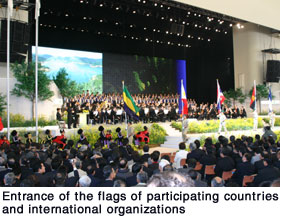 The opening ceremony for EXPO 2005 Aichi, Japan, the first World Exposition of the 21st century, was held on March 24 at EXPO Dome in the Nagakute Area. About 2,400 people participated in the opening ceremony. Their Majesties the Emperor and Empress and His Imperial Highness the Crown Prince (Honorary President of EXPO 2005) as well as Prime Minister Junichiro Koizumi (Honorary Chairman of EXPO 2005) attended the ceremony.
The opening ceremony for EXPO 2005 Aichi, Japan, the first World Exposition of the 21st century, was held on March 24 at EXPO Dome in the Nagakute Area. About 2,400 people participated in the opening ceremony. Their Majesties the Emperor and Empress and His Imperial Highness the Crown Prince (Honorary President of EXPO 2005) as well as Prime Minister Junichiro Koizumi (Honorary Chairman of EXPO 2005) attended the ceremony.EXPO 2005 official mascots Morizo and Kiccoro as well as children dressed up as butterflies, bees and other insects greeted participants from a stage-setting of rape blossoms. Yutaka Sado, who is active around the world, conducted the EXPO Super World Orchestra composed of top performers from 15 nations and provided an enchanting musical backdrop throughout the three-part opening ceremony. |
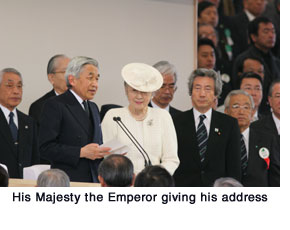 Part one was the ceremony section. The sound of the ancient Dotaku bell, which is said to summon the gods in Japan, resounded throughout the venue. Toshio Nakamura, Secretary-General of the Japan Association for the 2005 World Exposition, then declared the opening of EXPO 2005 Aichi, Japan. This was followed by the singing of the Japanese national anthem by internationally acclaimed soprano Shinobu Sato, the raising of the Japanese flag, the International Exhibitions Bureau flag (symbolizing world peace) and the EXPO 2005, Aichi, Japan flag. With the EXPO 2005 theme song “I’ll Be Your Love” in the background, the raising of the flags was followed by the entrance of the flags of the 121 participating countries and 4 international organizations.
Part one was the ceremony section. The sound of the ancient Dotaku bell, which is said to summon the gods in Japan, resounded throughout the venue. Toshio Nakamura, Secretary-General of the Japan Association for the 2005 World Exposition, then declared the opening of EXPO 2005 Aichi, Japan. This was followed by the singing of the Japanese national anthem by internationally acclaimed soprano Shinobu Sato, the raising of the Japanese flag, the International Exhibitions Bureau flag (symbolizing world peace) and the EXPO 2005, Aichi, Japan flag. With the EXPO 2005 theme song “I’ll Be Your Love” in the background, the raising of the flags was followed by the entrance of the flags of the 121 participating countries and 4 international organizations.The ceremony portion began with an opening address by Shoichiro Toyoda, Chairman of the Japan Association for the 2005 World Exposition. It was followed by speeches and welcome addresses by Masaaki Kanda, Governor of Aichi Prefecture; Junichiro Koizumi, Prime Minister of Japan; and Jianmin Wu, President of Bureau International des Expositions (BIE; International Exhibitions Bureau), and was concluded by a speech from His Majesty the Emperor. In his address, the Emperor said, “It is my sincere hope that this World Exposition will provide visitors from around the world with an excellent opportunity to deepen their understanding of the interactions between human beings and nature, inspiring them to work together to preserve the global environment in good condition.” Next, heralded by a trumpet played by a robot, 14 robots of three types that were introduced as “Humankind’s New Friends” exhibited their free and graceful movement on stage providing a glimpse into the cutting-edge technology that will be shown at EXPO 2005. At the climax of the ceremony section, His Imperial Highness the Crown Prince turned on a switch which triggered a music box set within a model of the Earth made of recycled glass to begin playing. The glass “Earth” then emitted bright lights and 100,000 leaves flowed down upon the event venue. Part one was concluded by the singing of “Share the World,” a song written to convey the message of EXPO 2005. The beautiful voices of boys and girls choirs accompanied by sign language and the sound of the saxophone performed by Sadao Watanabe, a world-famous Japanese jazz musician, Director-General of the Japan Pavilion Projects and composer of “Share the World,” filled the venue. |
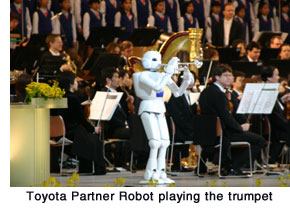 Part two was the “EXPO 2005 Symphony” which featured the performances of musical pieces that symbolized mutual understanding and sympathy of the people of the world. It began with a performance of “Jupiter” from Gustav Holst’s “Planet” Suite by the EXPO Super World Orchestra. The second piece was Frederic Chopin’s “Nocturne” (posthumous) by pianist Ingrid Fujiko Hemming. The third piece, from Igor Stravinsky’s “The Firebird,” featured an orchestral performance as well as ballet and enthralled the participants of the opening ceremony.
Part two was the “EXPO 2005 Symphony” which featured the performances of musical pieces that symbolized mutual understanding and sympathy of the people of the world. It began with a performance of “Jupiter” from Gustav Holst’s “Planet” Suite by the EXPO Super World Orchestra. The second piece was Frederic Chopin’s “Nocturne” (posthumous) by pianist Ingrid Fujiko Hemming. The third piece, from Igor Stravinsky’s “The Firebird,” featured an orchestral performance as well as ballet and enthralled the participants of the opening ceremony.Part three was a special program entitled “Welcome to EXPO 2005 Aichi, Japan.” It began with a gallant performance of Gojinjo Japanese drums in prayer of world peace and environmental protection. An original Kyogen (ancient traditional comical theatrical art) act was performed to appeal the importance of environmental conservation. Its theme was the single kernel of corn that had been passed out to all participants in the “Nature’s Wisdom bag.” “Children of the future” then suddenly appeared from above. They made an appeal for people to rise and work towards the future of the world. This and other various performances in Part three transmitted the message of EXPO 2005 to the world. The message from Wangari Maathai, involved in environmental conservation and the first African woman to receive the Nobel Peace Prize, also struck the hearts of those present. Toshio Nakamura, Secretary-General of the Japan Association for the 2005 World Exposition, gave the closing address. He said, “We tried to express Nature’s Wisdom, the theme of this World Exposition, in various ways in our opening ceremony. Did you like it?” These words were met by hearty applause from participants. EXPO 2005 Aichi, Japan has now finally commenced! |
![]()
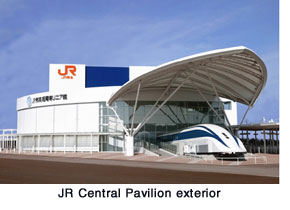 In December 2003, a “Superconducting Maglev” of the Central Japan Railway Company (JR Central) marked a world speed record of 581 km/h for a manned railway car on the Yamanashi Test Line. The train, which looks as if it is about to fly out of JR Central Pavilion, is the MLX01-1, the very Superconducting Maglev that was the leading car which marked this world record.
In December 2003, a “Superconducting Maglev” of the Central Japan Railway Company (JR Central) marked a world speed record of 581 km/h for a manned railway car on the Yamanashi Test Line. The train, which looks as if it is about to fly out of JR Central Pavilion, is the MLX01-1, the very Superconducting Maglev that was the leading car which marked this world record.The theme of JR Central Pavilion is “Superconducting Maglev takes off! -Beyond the threshold of existing surface transit systems-”. The aim of this pavilion is to transmit advanced Japanese Superconducting Maglev technology, the fundamental technology for which has been completed, to the world and to the future. |
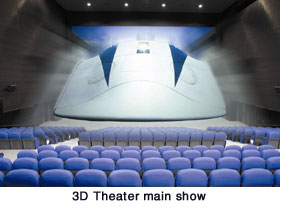 First, there is the 3D Theater. The pre-show, which is about 7 minutes long, will introduce the history of railways that led to the practical application of the Superconducting Maglev system. It includes information about this technological innovation as well as social background. This show will be presented on a 150-inch screen.
First, there is the 3D Theater. The pre-show, which is about 7 minutes long, will introduce the history of railways that led to the practical application of the Superconducting Maglev system. It includes information about this technological innovation as well as social background. This show will be presented on a 150-inch screen.The main show which follows is a 3D hi-vision document of about 12 minutes in length about the Superconducting Maglev. It is a dynamic piece presented on an 800-inch screen measuring 10 meters high and 18 meters wide. Visitors will see the maglev levitate and zoom overhead at a speed of 500km/h and experience realistic sound and breathtaking footage of a Superconducting Maglev in operation. |
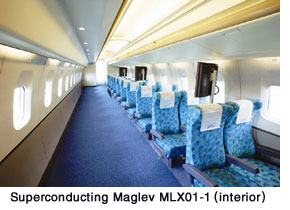 Next, there is the Superconducting Maglev MLX01-1. This is the actual leading car that marked a world speed record of 581km/h at the Yamanashi Test Line. Visitors will be able to experience the bogie installed with superconducting magnets, the lightweight design that has taken air-flow resistance thoroughly into account, and so on. Be sure to go onboard!
Next, there is the Superconducting Maglev MLX01-1. This is the actual leading car that marked a world speed record of 581km/h at the Yamanashi Test Line. Visitors will be able to experience the bogie installed with superconducting magnets, the lightweight design that has taken air-flow resistance thoroughly into account, and so on. Be sure to go onboard!Lastly, there is the experience at the Superconducting Technology Laboratory. In this area, visitors will be able to learn about the latest in Japan’s advanced technology related to Superconducting Maglev in an entertaining way. Launches of a spaceship model utilizing a high-temperature superconductive magnet of the world’s highest caliber as well as levitation using superconduction will be demonstrated here and will enable visitors to experience the power and wonder of superconductivity. There are three independent entrances leading respectively to the 3D Theater, Superconducting Maglev MLX01-1 and Superconducting Technology Laboratory. Visitors can choose the order in which they view these exhibits. Visit JR Central Pavilion and experience the world at 500km/h. |
![]()
![]()
 |
|
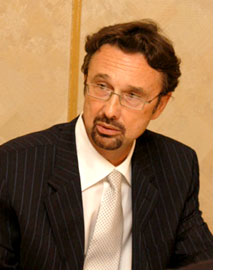 I think that it is always very difficult to relate nature with technology. This theme is a very interesting challenge for all participants of EXPO 2005 Aichi, Japan. I hope that Croatia has succeeded in bonding these two elements within our pavilion. I think that Japanese people are perhaps the best in the world at bringing such things to fruition.
I think that it is always very difficult to relate nature with technology. This theme is a very interesting challenge for all participants of EXPO 2005 Aichi, Japan. I hope that Croatia has succeeded in bonding these two elements within our pavilion. I think that Japanese people are perhaps the best in the world at bringing such things to fruition.EXPO 2005 will be bringing nature and technology - two issues that are completely different and at opposing poles - together in an impressive way through a beautiful venue filled with the splendor of nature, such as flowers, trees and gardens, as well as the latest technology as seen in the Linimo maglev train, IMTS unmanned buses, Fuel Cell Hybrid Buses, robots and many other things. Furthermore, the strength of EXPO 2005 is that the organizers have the overwhelming support of not only the Japanese government but also Japanese industries overall. It is extremely important when organizing an exposition of such a major scale that there is a firm financial foundation. I have had experiences with other World Expositions, and I think that construction is much ahead at this time. As compared with expositions of the past, they are very well organized and the preparations are being made well in advance. I have visited the EXPO 2005 site several times, and I think that the venue of the Expo matches its theme - Nature’s Wisdom - very well. The overall design of pavilions and makeup of EXPO 2005 created by the organizers also clearly express this main theme. Creating the Nature’s Wisdom theme and the efforts being made to realize it for the whole planet is, perhaps in itself, an expression of the “wisdom” of the Japanese people. In designing Croatia’s participation in EXPO 2005, our concept was to create a theme for our pavilion that was in line with the Nature’s Wisdom main theme. We chose, “A drop of water - a grain of salt” as the theme of our pavilion. Salt pans are a recognizable particularity of the Croatian landscape and history. Salt is the crown of a long process which consists of the hard work and patience of the Croatian people and the effects of the sun, the sea and the wind: therefore, it is a generous act of nature’s wisdom. *Editor’s note: this interview was conducted prior to the opening of EXPO 2005 |
|
![]()
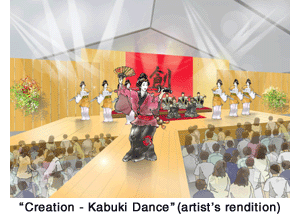 EXPO 2005 Aichi, Japan is an opportunity for visitors to experience a wide-range of the traditional cultures of the host country, Japan.
EXPO 2005 Aichi, Japan is an opportunity for visitors to experience a wide-range of the traditional cultures of the host country, Japan.First, there is Kabuki - one of the theatrical performing arts representative of Japan. It has its origins in the early 17th century. It has styles unique to its art, including the use of Oyama, or male actors who play female roles, and Kumadori make-up in which an actor’s role is dramatically expressed through facial make-up incorporating red, black, indigo, brown and other colors. In the “Performance of Kabuki Dance in Celebration of the Opening of EXPO 2005” which was held on March 25, 26 and 27 at EXPO Hall, Ganjiro Nakamura, designated a Living National Treasure, as well as other leading Kabuki actors captivated the audience with their superb acting and dance. “Creation - Kabuki Dance,” to be held on April 11 and 12 at Japan Plaza in front of Japan Pavilion Nagakute, is the first event of the Japan Hanaza Special Event series. The dynamism of Japanese dance, which is at the root of Kabuki, will be recreated by actors wearing costumes reminiscent of the age when Kabuki first originated. Other Japan Hanaza Special events through which visitors will be able to experience Japanese performing arts include Tempyo Music, an extravaganza in which Gagaku (ancient court music) and Bugaku (dance performed to Gagaku) from 1,250 years ago will be recreated. This will be held on May 30 and 31. The “Furyu Daidagaku (Artistic Percussion Fest)” on June 30 and July 1, produced by an up-and-coming Japanese drummer, is lively folk entertainment in which a large group of people in various costumes play festival music using gongs, drums and flutes, sing and dance. Furyu is at the root of the Japanese drum. There will also be a Tsugaru Shamisen (a type of three-stringed Japanese lute known for its thick and powerful sound) concert on July 21 and 22. |
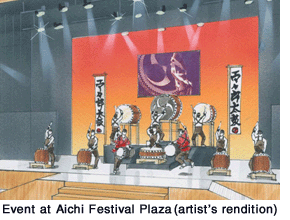 Another traditional theatrical performing art that visitors to EXPO 2005 will be able to enjoy is Nogaku Theater. Nogaku Theater, which has been passed down to the present from the 14th century, is another major traditional art. It is performed by actors wearing Noh masks. There are two types of Nogaku Theater: “Noh,” which expresses various aspects of human nature in each Noh play and lures audiences into a subtle and profound world, and “Kyogen,” which is cheerfully gay and comical.
Another traditional theatrical performing art that visitors to EXPO 2005 will be able to enjoy is Nogaku Theater. Nogaku Theater, which has been passed down to the present from the 14th century, is another major traditional art. It is performed by actors wearing Noh masks. There are two types of Nogaku Theater: “Noh,” which expresses various aspects of human nature in each Noh play and lures audiences into a subtle and profound world, and “Kyogen,” which is cheerfully gay and comical.“World Intangible Cultural Heritage ‘Nogaku Theater’- Crossing 1,000 Years in Time and Space” will be held on September 12. A dream team of 150 performers, including four Living National Treasures, will be coming together to transmit Japan’s tradtional culture to the world from EXPO Dome. Visitors to EXPO 2005 will also be able to experience a wide range of other traditional Japanese culture performed by citizens, such as folk entertainment and festivals. It should be interesting to choose an event from among the Civic Project events being held daily at Aichi Festival Plaza, EXPO Dome and other sites during a visit to the Expo. |
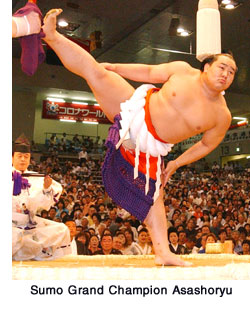 Another recommendation is participation in the tea ceremony, another representative cultural art. Tea ceremonies will be held on 84 days during EXPO 2005 at the Japanese Garden Tea-ceremony Room.
Another recommendation is participation in the tea ceremony, another representative cultural art. Tea ceremonies will be held on 84 days during EXPO 2005 at the Japanese Garden Tea-ceremony Room.Finally, there is the “Grand Sumo Tournament in EXPO 2005,” which will be held on April 4 at EXPO Dome. Sumo Grand Champion (Yokozuna) Asashoryu as well as other sumo wrestlers will be gathering to display their strength in heated bouts. It will be an event in which audiences will be able to fully enjoy the best of sumo, including entertaining demonstrations of Sumo Jinku, a type of folk song sung by sumo wrestlers, and Shokkiri (comic sumo) in which wrestlers will demonstrate the forty-eight basic sumo techniques. Enjoy traditional Japanese culture at EXPO 2005. |
| EXPO 2005 AICHI, JAPAN Newsletter | |
| To read past issues:Back Number | |
| Editor/Publisher: Japan Association for
the 2005 World Exposition Head Office: 1533-1 Ibaragabasama, Nagakute-cho Aichi 480-1101 Japan Nagoya Office: Nagoya Daiya II Bldg 4F, 3-15-1 Meieki Nakamura-ku, Nagoya, Aichi 450-0002 Japan Tokyo Office: Iino Bldg 8F, 2-1-1 Uchisaiwai-cho Chiyoda-ku, Tokyo 100-0011 Japan |
 |
© Japan Association for the 2005 World Exposition
